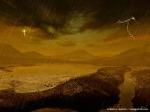
|
You entered: life
 Curiosity on Mars: Mt Sharp in View
Curiosity on Mars: Mt Sharp in View
27.08.2012
What's that on the horizon? The light peak is Mt. Sharp -- an eventual destination of the Curiosity rover. The above image mosaic was taken from Bradbury Landing, the landing spot of Curiosity, and shows in the foreground the rover's extended robotic arm.
 Edmund Halley's Greatest Discoveries
Edmund Halley's Greatest Discoveries
6.07.1996
Sir Edmond Halley was quite a discoverer. Born in 1656, he computed in 1705 that a bright comet was periodic and would make another appearance in 1758. The comet appeared as predicted and is now known as Comet Halley. Unfortunately, Halley died in 1742 and never saw his prediction come true.
 Europa: Ice Line
Europa: Ice Line
18.12.2004
This bright white swath cutting across the surface of icy Jovian moon Europa is known as Agenor Linea. In all about 1000 kilometers long and 5 kilometers wide, only a section is pictured here as part of a combined color and black and white image based on data from the Galileo spacecraft.
 Disorder in Stephan's Quintet
Disorder in Stephan's Quintet
10.01.1998
What are five closely grouped galaxies doing in this image? The grouping is commonly known as Stephan's Quintet. Four of the galaxies show essentially the same redshift suggesting that they are at the same distance from us.
 Arecibo: The Largest Telescope
Arecibo: The Largest Telescope
9.03.1996
The Arecibo radio telescope is currently the largest single-dish telescope in the world. First opening in 1963, this 305 meter (1000 foot) radio telescope resides in a natural valley of Puerto Rico. The Arecibo...
 Vega
Vega
15.07.1997
Vega is a bright blue star 25 light years away. Vega is the brightest star in the Summer Triangle, a group of stars easily visible summer evenings in the northern hemisphere. The name Vega...
 Methane Rain Possible on Titan
Methane Rain Possible on Titan
2.08.2006
Might it rain cold methane on Saturn's Titan? Recent analyses of measurements taken by the Huygen's probe that landed on Titan in 2005 January indicate that the atmosphere is actually saturated with methane at a height of about 8 kilometers.
 Planets Around Sun-Like Stars
Planets Around Sun-Like Stars
31.01.1996
Do many Sun-like stars have planets? Speculation on this point has been ongoing since humanity's realization that other stars existed. Only in the past year, however, have answers and discoveries been realized. The above plot summarizes the four known cases of normal stars having planets.
 The Millennium that Defines Universe
The Millennium that Defines Universe
1.01.2000
Welcome to the millennial year at the threshold of millennium three. During millennium two, humanity continually redefined its concept of "Universe": first as spheres centered on the Earth, in mid-millennium as the Solar System, a few centuries ago as the Galaxy, and within the last century as the matter emanating from the Big Bang.
 Jets from the Necklace Nebula
Jets from the Necklace Nebula
18.05.2021
What celestial body wears the Necklace Nebula? First, analyses indicate that the Necklace is a planetary nebula, a gas cloud emitted by a star toward the end of its life. Also, what appears to be diamonds in the Necklace are actually bright knots of glowing gas.
|
January February March April May June July August September October November December |
||||||||||||||||||||||||||||||||||||||||||||||||||||||||